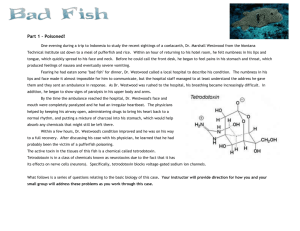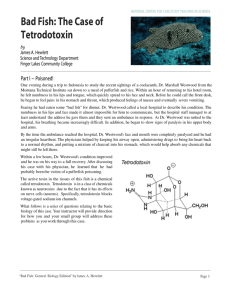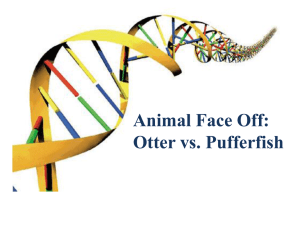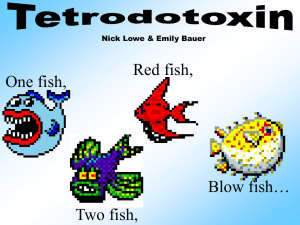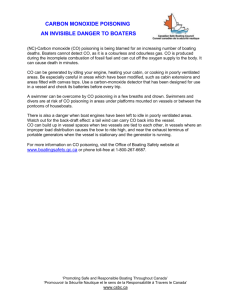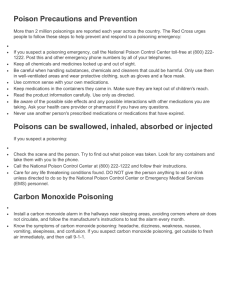Conotoxins
advertisement
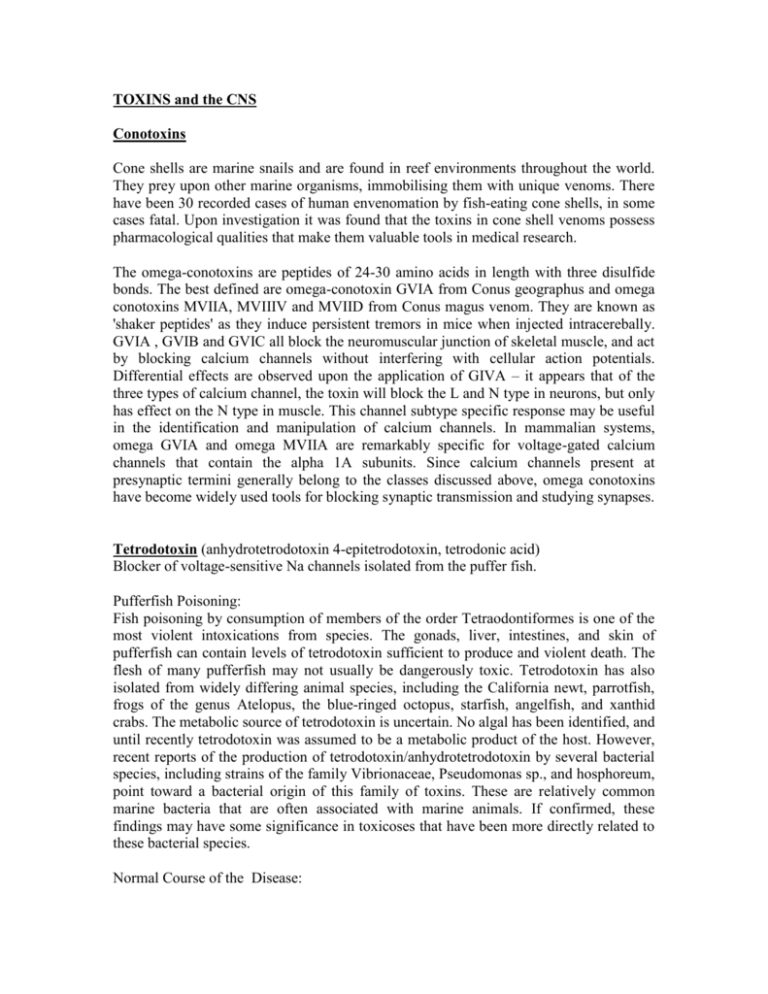
TOXINS and the CNS Conotoxins Cone shells are marine snails and are found in reef environments throughout the world. They prey upon other marine organisms, immobilising them with unique venoms. There have been 30 recorded cases of human envenomation by fish-eating cone shells, in some cases fatal. Upon investigation it was found that the toxins in cone shell venoms possess pharmacological qualities that make them valuable tools in medical research. The omega-conotoxins are peptides of 24-30 amino acids in length with three disulfide bonds. The best defined are omega-conotoxin GVIA from Conus geographus and omega conotoxins MVIIA, MVIIIV and MVIID from Conus magus venom. They are known as 'shaker peptides' as they induce persistent tremors in mice when injected intracerebally. GVIA , GVIB and GVIC all block the neuromuscular junction of skeletal muscle, and act by blocking calcium channels without interfering with cellular action potentials. Differential effects are observed upon the application of GIVA – it appears that of the three types of calcium channel, the toxin will block the L and N type in neurons, but only has effect on the N type in muscle. This channel subtype specific response may be useful in the identification and manipulation of calcium channels. In mammalian systems, omega GVIA and omega MVIIA are remarkably specific for voltage-gated calcium channels that contain the alpha 1A subunits. Since calcium channels present at presynaptic termini generally belong to the classes discussed above, omega conotoxins have become widely used tools for blocking synaptic transmission and studying synapses. Tetrodotoxin (anhydrotetrodotoxin 4-epitetrodotoxin, tetrodonic acid) Blocker of voltage-sensitive Na channels isolated from the puffer fish. Pufferfish Poisoning: Fish poisoning by consumption of members of the order Tetraodontiformes is one of the most violent intoxications from species. The gonads, liver, intestines, and skin of pufferfish can contain levels of tetrodotoxin sufficient to produce and violent death. The flesh of many pufferfish may not usually be dangerously toxic. Tetrodotoxin has also isolated from widely differing animal species, including the California newt, parrotfish, frogs of the genus Atelopus, the blue-ringed octopus, starfish, angelfish, and xanthid crabs. The metabolic source of tetrodotoxin is uncertain. No algal has been identified, and until recently tetrodotoxin was assumed to be a metabolic product of the host. However, recent reports of the production of tetrodotoxin/anhydrotetrodotoxin by several bacterial species, including strains of the family Vibrionaceae, Pseudomonas sp., and hosphoreum, point toward a bacterial origin of this family of toxins. These are relatively common marine bacteria that are often associated with marine animals. If confirmed, these findings may have some significance in toxicoses that have been more directly related to these bacterial species. Normal Course of the Disease: The first symptom of intoxication is a slight numbness of the lips and tongue, appearing between 20 minutes to three hours after eating poisonous pufferfish. The next symptom is increasing paraesthesia in the face and extremities, which may be followed by sensations of lightness or floating. Headache, epigastric pain, nausea, diarrhea, and/or vomiting may occur., some reeling or difficulty in walking may occur. The second stage of the intoxication is increasing paralysis. Many victims are unable to move; even sitting may be difficult. There is increasing respiratory distress. Speech is affected, the victim usually exhibits dyspnea, cyanosis, and hypotension. Paralysis increases and convulsions, mental impairment, and cardiac arrhythmia may occur. The victim, although completely paralyzed, may be conscious and in some cases completely lucid until shortly before death. Death usually occurs within 4 to 6 hours, with a known range of about 20 minutes to 8 hours. Associated Foods: Poisonings from tetrodotoxin have been almost exclusively associated with the consumption of pufferfish from waters of the Indo-Pacific ocean regions. Several reported cases of poisonings, including fatalities, involved pufferfish from the Atlantic Ocean, Gulf of Mexico, and Gulf of California. There have been no confirmed cases of poisoning from the Atlantic pufferfish, Spheroides maculatus. However, in one study, extracts from fish of this species were highly toxic in mice. The trumpet shell Charonia sauliae has been implicated in food poisonings, and evidence suggests that it contains a tetrodotoxin derivative. There have been several reported poisonings from mislabelled pufferfish and at least one report of a fatal episode when an individual swallowed a California newt. Relative Frequency of Disease: From 1974 through 1983 there were 646 reported cases of pufferfish poisoning in Japan, with 179 fatalities. Estimates as high as 200 cases per year with mortality approaching 50% have been reported. Only a few cases have been reported in the United States, and outbreaks in countries outside the Indo-Pacific area are rare. as their trimethylsilyl derivatives by gas chromatography/mass spectrometry. These chromatographic methods have not yet been validated. Pufferfish poisoning is a continuing problem in Japan, affecting 30 - 100 persons/year. Most of these poisoning episodes occur from home preparation and consumption and not from commercial sources of the pufferfish. Three deaths were reported in Italy in 1977 following the consumption of frozen pufferfish imported from Taiwan and mislabelled as angler fish.
